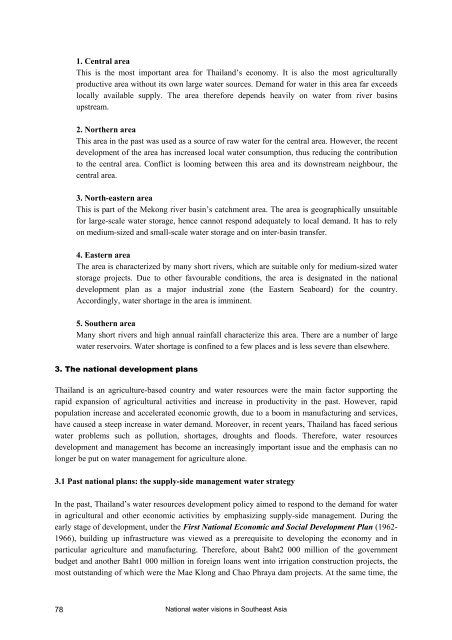The FAO-ESCAP pilot project on national water visions. From vision ...
The FAO-ESCAP pilot project on national water visions. From vision ...
The FAO-ESCAP pilot project on national water visions. From vision ...
You also want an ePaper? Increase the reach of your titles
YUMPU automatically turns print PDFs into web optimized ePapers that Google loves.
1. Central area<br />
This is the most important area for Thailand’s ec<strong>on</strong>omy. It is also the most agriculturally<br />
productive area without its own large <strong>water</strong> sources. Demand for <strong>water</strong> in this area far exceeds<br />
locally available supply. <str<strong>on</strong>g>The</str<strong>on</strong>g> area therefore depends heavily <strong>on</strong> <strong>water</strong> from river basins<br />
upstream.<br />
2. Northern area<br />
This area in the past was used as a source of raw <strong>water</strong> for the central area. However, the recent<br />
development of the area has increased local <strong>water</strong> c<strong>on</strong>sumpti<strong>on</strong>, thus reducing the c<strong>on</strong>tributi<strong>on</strong><br />
to the central area. C<strong>on</strong>flict is looming between this area and its downstream neighbour, the<br />
central area.<br />
3. North-eastern area<br />
This is part of the Mek<strong>on</strong>g river basin’s catchment area. <str<strong>on</strong>g>The</str<strong>on</strong>g> area is geographically unsuitable<br />
for large-scale <strong>water</strong> storage, hence cannot resp<strong>on</strong>d adequately to local demand. It has to rely<br />
<strong>on</strong> medium-sized and small-scale <strong>water</strong> storage and <strong>on</strong> inter-basin transfer.<br />
4. Eastern area<br />
<str<strong>on</strong>g>The</str<strong>on</strong>g> area is characterized by many short rivers, which are suitable <strong>on</strong>ly for medium-sized <strong>water</strong><br />
storage <str<strong>on</strong>g>project</str<strong>on</strong>g>s. Due to other favourable c<strong>on</strong>diti<strong>on</strong>s, the area is designated in the nati<strong>on</strong>al<br />
development plan as a major industrial z<strong>on</strong>e (the Eastern Seaboard) for the country.<br />
Accordingly, <strong>water</strong> shortage in the area is imminent.<br />
5. Southern area<br />
Many short rivers and high annual rainfall characterize this area. <str<strong>on</strong>g>The</str<strong>on</strong>g>re are a number of large<br />
<strong>water</strong> reservoirs. Water shortage is c<strong>on</strong>fined to a few places and is less severe than elsewhere.<br />
3. <str<strong>on</strong>g>The</str<strong>on</strong>g> nati<strong>on</strong>al development plans<br />
Thailand is an agriculture-based country and <strong>water</strong> resources were the main factor supporting the<br />
rapid expansi<strong>on</strong> of agricultural activities and increase in productivity in the past. However, rapid<br />
populati<strong>on</strong> increase and accelerated ec<strong>on</strong>omic growth, due to a boom in manufacturing and services,<br />
have caused a steep increase in <strong>water</strong> demand. Moreover, in recent years, Thailand has faced serious<br />
<strong>water</strong> problems such as polluti<strong>on</strong>, shortages, droughts and floods. <str<strong>on</strong>g>The</str<strong>on</strong>g>refore, <strong>water</strong> resources<br />
development and management has become an increasingly important issue and the emphasis can no<br />
l<strong>on</strong>ger be put <strong>on</strong> <strong>water</strong> management for agriculture al<strong>on</strong>e.<br />
3.1 Past nati<strong>on</strong>al plans: the supply-side management <strong>water</strong> strategy<br />
In the past, Thailand’s <strong>water</strong> resources development policy aimed to resp<strong>on</strong>d to the demand for <strong>water</strong><br />
in agricultural and other ec<strong>on</strong>omic activities by emphasizing supply-side management. During the<br />
early stage of development, under the First Nati<strong>on</strong>al Ec<strong>on</strong>omic and Social Development Plan (1962-<br />
1966), building up infrastructure was viewed as a prerequisite to developing the ec<strong>on</strong>omy and in<br />
particular agriculture and manufacturing. <str<strong>on</strong>g>The</str<strong>on</strong>g>refore, about Baht2 000 milli<strong>on</strong> of the government<br />
budget and another Baht1 000 milli<strong>on</strong> in foreign loans went into irrigati<strong>on</strong> c<strong>on</strong>structi<strong>on</strong> <str<strong>on</strong>g>project</str<strong>on</strong>g>s, the<br />
most outstanding of which were the Mae Kl<strong>on</strong>g and Chao Phraya dam <str<strong>on</strong>g>project</str<strong>on</strong>g>s. At the same time, the<br />
78<br />
Nati<strong>on</strong>al <strong>water</strong> visi<strong>on</strong>s in Southeast Asia
















